Portrait Miniatures
“We heard the turning of a key in a small lock; she has opened a secret drawer of an escritoire, and is probably looking at a certain miniature, done in Malbone’s most perfect style, and representing a face worthy of no less delicate a pencil. It was once our good fortune to see this picture. It is the likeness of a young man, in a silken dressing-gown of an old fashion, the soft richness of which is well adapted to the countenance of reverie, with its full, tender lips, and beautiful eyes, that seem to indicate not as much capacity of thought, as gentle and voluptuous emotion”
– Nathaniel Hawthorne, 1851
Portrait miniatures were intensely intimate objects that linked together the sitter, viewer, and wearer and communicated their relationship to one another. The potent reverential symbolism of miniatures was well understood by portrait miniaturists. For example, Charles Fraser in his eulogy for fellow miniaturist, Edward Greene Malbone, lauded, “He imparted such life to the ivory, and produced such striking resemblances, that they will never fail to perpetuate the tenderness of friendship, to divert the care of absence, and to aid affection in dwelling on those features and that image, which death has forever wrested in it.”
Portrait miniature on ivory by Thomas Hazelhurst, signed “T.H.” The reverse features basket weave hairwork surrounded by translucent blue enamel and backed with embossed foil. Scale in centimeters.
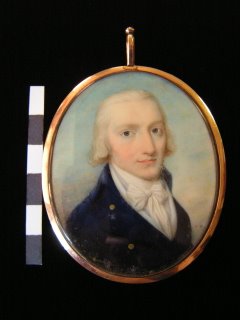
English portrait miniature with dark blue silk moire on the reverse.
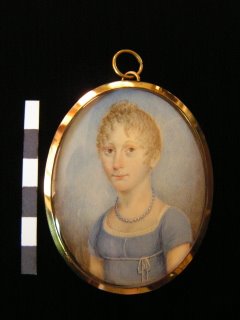
English portrait miniature on ivory…

With a palette worked curl and blue enamel initial plaque on the reverse.
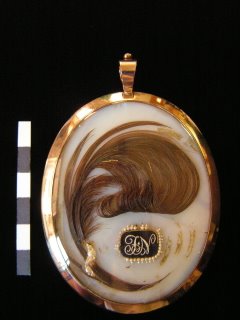
Portrait miniature on ivory signed “E. Taylor 1827” along the right edge. In addition to miniature painting, Taylor was also a jeweler and probably crafted the silver brooch with a black enamel band specifically for this miniature.

On the reverse, a palette worked curl on black fabric.

French portrait miniature by Jean-Baptiste Soyer, the reverse of which houses the most incredible hairwork I’ve ever seen: a family of birds nesting among three sheaths of wheat.
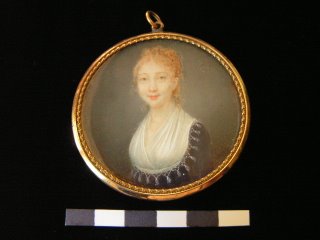

The sheath of wheat was a popular symbol for prosperity and fecundity, and the two brooches below represent hairwork wheat framed by laurels.
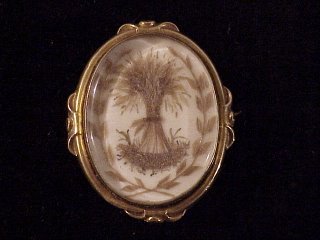

Happiness
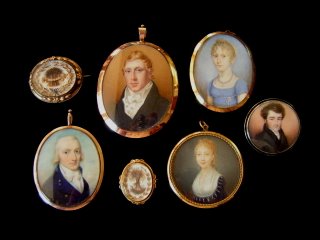
– Nathaniel Hawthorne, 1851
Portrait miniatures were intensely intimate objects that linked together the sitter, viewer, and wearer and communicated their relationship to one another. The potent reverential symbolism of miniatures was well understood by portrait miniaturists. For example, Charles Fraser in his eulogy for fellow miniaturist, Edward Greene Malbone, lauded, “He imparted such life to the ivory, and produced such striking resemblances, that they will never fail to perpetuate the tenderness of friendship, to divert the care of absence, and to aid affection in dwelling on those features and that image, which death has forever wrested in it.”
Portrait miniature on ivory by Thomas Hazelhurst, signed “T.H.” The reverse features basket weave hairwork surrounded by translucent blue enamel and backed with embossed foil. Scale in centimeters.

English portrait miniature with dark blue silk moire on the reverse.

English portrait miniature on ivory…

With a palette worked curl and blue enamel initial plaque on the reverse.

Portrait miniature on ivory signed “E. Taylor 1827” along the right edge. In addition to miniature painting, Taylor was also a jeweler and probably crafted the silver brooch with a black enamel band specifically for this miniature.

On the reverse, a palette worked curl on black fabric.

French portrait miniature by Jean-Baptiste Soyer, the reverse of which houses the most incredible hairwork I’ve ever seen: a family of birds nesting among three sheaths of wheat.


The sheath of wheat was a popular symbol for prosperity and fecundity, and the two brooches below represent hairwork wheat framed by laurels.


Happiness




0 Comments:
Post a Comment
<< Home